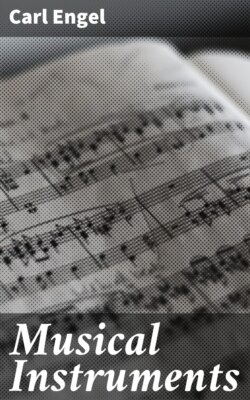Musical Instruments

Реклама. ООО «ЛитРес», ИНН: 7719571260.
Оглавление
Engel Carl. Musical Instruments
Musical Instruments
Table of Contents
CHAPTER I
CHAPTER II
Pre-historic Relics
The Ancient Egyptians
CHAPTER III
The Assyrians
The Hebrews
CHAPTER IV
The Greeks
The Etruscans and Romans
CHAPTER V
The Chinese
The Hindus
The Persians and Arabs
CHAPTER VI
The American Indians
CHAPTER VII
European Nations during the Middle Ages
CHAPTER VIII
CHAPTER IX
CHAPTER X
Post-mediæval Musical Instruments
INDEX
Отрывок из книги
Carl Engel
Published by Good Press, 2022
.....
The Egyptians possessed various kinds of harps, some of which were elegantly shaped and tastefully ornamented. The largest were about six and a half feet high; and the small ones frequently had some sort of stand which enabled the performer to play upon the instrument while standing. The name of the harp was buni. Its frame had no front pillar; the tension of the strings therefore cannot have been anything like so strong as on our present harp.
The Egyptian harps most remarkable for elegance of form and elaborate decoration are the two which were first noticed by Bruce, who found them painted in fresco on the wall of a sepulchre at Thebes, supposed to be the tomb of Rameses III. who reigned about 1250 B.C. Bruce’s discovery created sensation among the musicians. The fact that at so remote an age the Egyptians should have possessed harps which vie with our own in elegance and beauty of form appeared to some so incredible that the correctness of Bruce’s representations, as engraved in his “Travels,” was greatly doubted. Sketches of the same harps, taken subsequently and at different times from the frescoes, have since been published, but they differ more or less from each other in appearance and in the number of strings. A kind of triangular harp of the Egyptians was discovered in a well-preserved condition and is now deposited in the Louvre. It has twenty-one strings; a greater number than is generally represented on the monuments. All these instruments, however much they differed from each other in form, had one peculiarity in common, namely the absence of the fore pillar.
.....